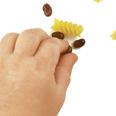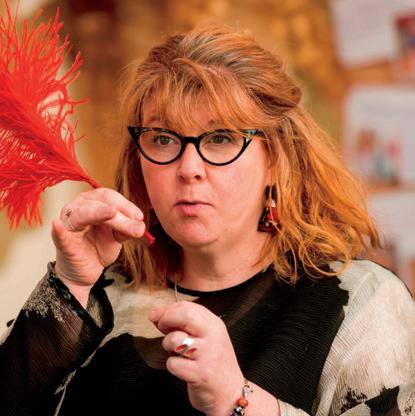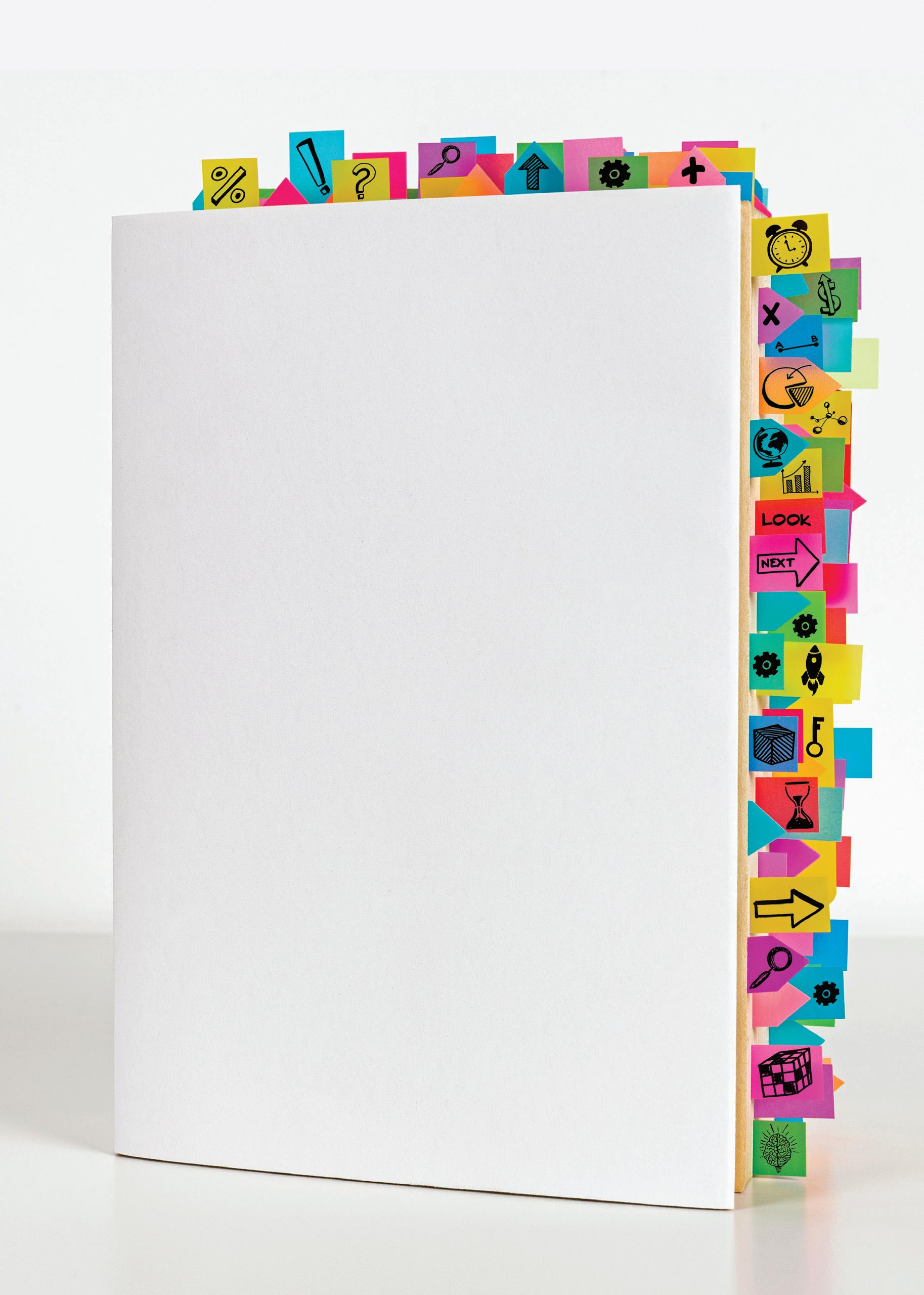Ready for anything
Are your plans in place for an emergency?
Menopause
Don’t suffer in silence – educate yourself and others

Gifted children




How to help them flourish in your setting


Are your plans in place for an emergency?
Menopause
Don’t suffer in silence – educate yourself and others

Gifted children




How to help them flourish in your setting

Ga rdening has huge benefits for Gardening has benefits children’s lea r ning a nd development children’s learning and
























































Welcome to your first edition of Childcare Professional in 2023. As many of you will know, this year we have begun a new and exciting chapter at PACEY: I started as Chief Executive last month, taking over from Liz Bayram who worked with PACEY staff, volunteers and Trustees for 15 years.

Some of you may recognise me from my previous role as PACEY’s
EDITORIAL
The magazine of the Professional Association for Childcare and Early Years
PACEY
Northside House, Third floor
69 Tweedy Road, Bromley, Kent, BR1 3WA 0300 003 0005 pacey.org.uk magazine@pacey.org.uk
ADVERTISING
childcareprofessional@ redactive.co.uk
020 7880 7668

Policy Advisor, where I became familiar with the significant challenges that you face in your roles and your vital part in building strong foundations for children. My priority is to ensure that PACEY remains a strong advocate for registered childminders, nurseries, pre-schools and nannies – to be by your side, championing your vital work and calling on government to provide greater investment and support.
Executive Editors Angela Gamble, Ka Lai Brightley Hodges
Editor Helen Bird
Managing Editor Aviva Attias
Assistant Editor Hollie Ewers
Sub-Editors James Hundleby, Amy Beveridge
DESIGN
Senior Designers Gene Cornelius, Sarah Auld
Picture Researcher Jessica Marsh
PRODUCTION
Production Director
Jane Easterman
Account Director Emma Godfrey
Cover image Alamy Printed by Precision Colour Printing.
We want to keep up the momentum from the end of last year, when we saw a growing coalition of voices demanding reforms to improve the early education and childcare system for families and providers and better support the many children affected by the impacts of the pandemic.
So please stay in touch with us as your voices and experiences are central to this. Keep an eye on PACEY’s channels over the coming weeks where I will be talking more about my vision for PACEY in 2023 and beyond and getting to know you as members.
Helen Donohoe PACEY Chief ExecutivePUBLISHED BY Redactive Publishing Ltd

9 Dallington Street, London EC1V 0LN

020 7880 6200
Whilst we take reasonable care to ensure the content of this magazine informs best practice in childcare and early years and is correct at the time of going to print, it is not a substitute for professional advice tailored to your specific requirements. We cannot be held responsible for any losses, damage or distress arising from your reliance on content or advertising whether caused by our negligence or otherwise. Opinions are those of
the authors and do not necessarily reflect our corporate view. Products and services advertised will not be suitable for everyone and you should address queries to the advertiser directly. You may reproduce non-advertising content without charge for educational purposes only, provided you acknowledge this magazine as the source. We reserve the right to modify and edit submitted material which we will only return to you (at your risk) if you ask us to do so when you send us the material.
Registered Charity No: 295981




© Professional Association for Childcare and Early Years 2023. All rights reserved.
The envelope your magazine has arrived in is 100% recyclable.




Last month we welcomed Helen Donohoe as PACEY’s Chief Executive, as Liz Bayram departed PACEY after 15 years of working with PACEY trustees, staff and volunteers. Helen said: “I am honoured to have the opportunity to lead PACEY as its next Chief Executive and to continue to ensure we are there to support our members, championing their vital work and ensuring PACEY remains a strong voice for everyone working in early years and childcare.” pacey.org.uk/







PACEY is supporting the UK Parliament Education Committee’s inquiry into support for early years and childcare. Our Chief Executive attended the first witness session to give evidence on the issues facing our sector last month. We thank all those who have shared their experiences and engaged with this work. pacey.org.uk/ early-years-inquiry



HM Revenue & Customs has announced that self-employed individuals and landlords will have longer to prepare for Making Tax Digital for Income Tax SelfAssessment. The mandatory use of digital software is being phased in from April 2026, rather than April 2024. pacey.org.uk/ delays-MTD


delays-MT



Help!
pacey.org.uk/helprisk-assessment
The power of music
pacey.org.uk/ power-of-music
Spotting the signs of harmful sexual behaviour
pacey.org.uk/ signs-harmfulbehaviour







On 31 January, Care Inspectorate Wales opened the Self-Assessment of Service Statement (SASS) that is required to be submitted by all providers in Wales.




















It is extremely important that providers submit this in advance of the deadline to meet regulatory requirements. pacey.org.uk/CIW-SASSJan23-update


Claire Protheroe, Head of Contracts and Projects at PACEY, featured on BBC Wales Live in December. The programme focused on the cost of childcare in Wales. Claire shared the perspective from the childcare sector on the challenges it is facing. pacey.org.uk/ pacey-cymru-bbc




“I love the monthly planners; they really help me get my head into gear for planning! I plan in the moment, but they give me a good overview for wider things that might be coming up in the children’s home lives or for inspiration to extend their interests in other ways.”
“I love that they run for one hour (bitesize but full of info), always have great speakers, knowledgeable, relevant.”








Protecting the children we care for from harm is an ongoing requirement – and it concerns everyone. According to the NSPCC, the number of children receiving care and support from child protection plans and




registers in the UK in 2020 reached more than 58,000. A joined-up approach to safeguarding is needed more than ever.

Childcare providers have a duty and responsibility to report safeguarding concerns.



In England the Early Years Foundation Stage



statutory framework states that providers “must be alert to any issues for concern in the child’s life at home or elsewhere” and “must have and implement a policy and procedures to safeguard children”.
In Wales, standard 20 of the National Minimum Standards stipulates that children “are protected from harm and abuse






Keeping children safe is everyone’s business, so a joined-up approach between services is vital. We break down the best practice procedures for England and Wales.


Contact the local authority children’s social care and/or the police. They will advise you of the next steps to take.
Follow the advice of the local authority children’s social care and/or the police. Make a report verbally and follow up any written requirements within 24 hours.
If any person has knowledge, concerns or suspicions that a child is suffering, has suffered, or is likely to be at risk of harm, it is their responsibility to ensure that the concerns are referred to local authority children’s social care/local safeguarding partners and/or the police.
Share information with the designated safeguarding officer within your setting. If you’re a childminder and the safeguarding lead for your setting, follow your policy and procedure.



Still have a concern that a child is experiencing or at risk of abuse, neglect or other kinds of harm?
Share information with parents/carers if it’s safe to do so, advice can be sought from the local authority children’s social care if needed.
Keep accurate records and ensure ongoing monitoring of the child – refer to your setting policy for how to record a concern.
and parents are confident that all possible steps to protect children from abuse are taken”.


The flowcharts shown above – for England and Wales respectively – are designed to remind you of the correct procedure




Share information with parents/carers and consider if the child or family needs additional support. Refer to information, advice, guidance, and support services with the permission of the parents/carers.
to follow if you have a concern.
For providers in Wales, the procedure shown in the flowchart is universal.
But in England each local authority has a specific way of managing safeguarding, meaning the onus is on the individual practitioner
Is the child at immediate risk?
Contact the duty officer within the relevant social services department and/or the police. They will advise you of the next steps to take.
Share information with the designated safeguarding officer within your setting. If you’re a childminder and the safeguarding lead for your setting, follow your policy and procedure.
Follow the advice of social services and/or the police. Make a report verbally and follow up any written requirements within 24 hours.
If any person has knowledge, concerns,or suspicions that a child is suffering, has suffered, or is likely to be at risk of harm, it is their responsibility to ensure that the concerns are referred to social services and/or the police.
Still have a concern that a child is experiencing or at risk of abuse, neglect or other kinds of harm?
Share information with parents/carers if it’s safe to do so. Advice can be sought from social services if needed.
to know your local arrangements – which should be in your setting’s safeguarding policy.
If you and your setting plan appropriately and stick to the agreed policies and procedures, then the children in your care are sure to be in safe hands. CP
Keep accurate records and ensure ongoing monitoring of the child – refer to your setting policy for how to record a concern.
Share information with parents/carers and consider if the child or family needs additional support. Refer to information, advice, guidance and support services with the permission of the parents/carers.
PACEY’s main safeguarding page: pacey.org.uk/mypacey/safeguarding Ofsted guidance on inspecting safeguarding in early years, education and skills (England): bit.ly/ofsted-safeguarding-inspection Working together to safeguard children (England): bit.ly/gov-working-together
Safeguarding procedures (Wales): safeguarding.wales/en
We speak to adventurer and children’s author Lindsey Cole about how her swim down the Thames dressed as a mermaid is inspiring young environmentalists.

With so much information about the world available at our fingertips, it’s almost incredible to think that there are still adventurers out there. But whether it is circumnavigating Australia with truck drivers or – as we shall see –swimming in some fairly unusual places, Lindsey Cole prioritises lived experience above theoretical knowledge.
“When I was travelling in Australia, I read a book called Follow the RabbitProof Fence, which is based on the true story of three Aboriginal girls who were forcibly removed from their home in 1931 and taken to a


settlement to be assimilated into white society,” Lindsey says.


“A few months after I finished it, my dad died suddenly – I spoke to him in the morning and I said
I’d call him later because I didn’t have time to chat, but he had died by the time I could call back. I really struggled to deal with the grief and started selfharming because of the guilt I felt. But due to the timing between reading the book and my dad dying, I just kept thinking about the three girls. They were the epitome of heroes.
“When I came back to the UK, I signed up to do the London Triathlon. Every time I struggled with it, I thought about the girls. As I did more adventures over the years, whenever I struggled, I thought about the girls. So six years ago I
decided to go back to Australia and walk across the country, retracing their journey. I was even taken in by their family; it was the most beautiful experience.”
While Lindsey’s Follow the Rabbit-Proof Fence adventure holds special memories for her personally, the turning point in her writing career actually came just a little later.
“After that walk, which took three months, I went to Bali to rest and
recuperate. There, I learnt to freedive. One evening, on an ascent, I felt a sting on my hand. I thought it was a jellyfish bobbing away, but it was a bit of plastic that had cut me,” Lindsey says.
“The next day, scrolling through my phone, I saw photos of people diving wearing mermaid tails. I thought, why not try to swim the length of the River Thames as a mermaid to highlight how we are choking our waterways with plastic?”
In 2018 that idea became reality, and Lindsey swam the length of the Thames dressed as a mermaid, accompanied by friend and artist Barbara de Moubray in a canoe. While the swim in itself was notable, it was when Lindsey rescued a cow that had fallen into the river that she made national and even international news. That escapade turned her urban mermaid adventure into something more mythical – and literal.
“I ended up in The Sun and on the BBC, and there

“I thought, why not try to swim the length of the River Thames as a mermaid to highlight how we are choking our waterways with plastic?”
was even a cartoon made about me in Sweden,” Lindsey says.

“Because of the interest in my meeting with the cow, I decided to turn the adventure into a children’s book. It’s actually a really fun way to talk about the problem of plastic. I think there is a lot of doom and gloom in the environmental world, so the friendship between the mermaid and the cow seemed a much more fun way to talk about the plastic problem.
“A headteacher emailed me and asked for permission to turn my story into a school play because she said it had all the ingredients of a great children’s story. That’s true: if it was just about me and a load of rubbish, that’s an old story. But when you add the cow into things, it makes it more humorous. Also, I

“In the back of The Mermaid and the Cow, I give tips on what you can do to make spreading the eco message more fun. One thing is to turn it into a game. For example: how many pieces of litter can you pick up today?” Lindsey says. “Sometimes when I go into schools, I get teachers to ask the children to collect all the packaging from what they used at home that week, and
never realised how much children like mermaids, but they really do!”




In fact, such has been the reaction to her book The Mermaid and the Cow, Lindsey has decided to write a whole series, with each book based on one of her real-life mermaid adventures. She has already swum up the Bristol Avon towing a poo sculpture to highlight the damage sewage pollution is doing to local wildlife, and is in the early stages of planning a swim in the Arctic to highlight melting sea ice in a book that will be called The Mermaid and the Polar Bear.
“I think it’s important for everyone to learn about environmental issues, and I think it’s good to make children feel empowered.
then we make a mural out of it. That reminds them of all the things they use and all the waste it creates.
“So just be light-hearted and fun. It’s a bit like the difference between saying don’t do something – ‘don’t’ is negative language – and saying do something, which makes it fun and positive. If you turn it into a game, they don’t even know they’re being helpful.”
For more on Lindsey and her work visit lindseycole.co.uk
They are the future generation and they can change the world that previous generations have messed up. Adults can get a bit tired because they have so many responsibilities. But children have no fear – give them the information and see what they can do with it,” Lindsey says.
“What I really love is the idea of magic, because once you get older you don’t really have the same aspect of magic in life any more. Some children don’t think I’m really a mermaid and they tell me. But even the fact they have to say it means that they are not entirely sure.
“One thing I’d like them to take away is the idea that they can do whatever they want. I hope it inspires them so if they have an idea, they can just run – or even swim – with it.” CP
Agood starting point is to recognise that when a child is showing signs of stress, their brain is being overwhelmed by stimuli. This causes stress hormones to trigger a range of responses, including fight or flight. For some children who have had restricted opportunities to be out and about during Covid-19 or who have missed out on group play, being in an early years setting with other children has the potential to be overwhelming.

While a hectic, busy, and loud environment may seem stimulating, it can cause children who are feeling stressed to become overwhelmed. Over time and with support, the aim will be to help children to regulate themselves so that they can become more resilient. There are a few things that can make a significant difference to help these children: Aim for calm starts and ending to sessions and any transitions Model being calm and slow for parents who arrive stressed for drop-offs and pick-ups

Since lockdown, many more children have been showing signs of stress, says PACEY President Penny Tassoni. These can manifest as difficulty sleeping, tantrums, clinginess or aggression. So what can practitioners do?

Look for ways of reducing noise and visual distraction in the environment: for example, noisy toys or children running around Too much choice can be stressful for some children to start with – be ready to guide children with their play Recognise that some children need to play alone before being ready to join others.
Children who are stressed also need a lot of predictability: Create routines for individual children Aim to be consistent in your responses so that children do not need to second-guess your reaction
Give children plenty of warning when something is about to change Use visual storyboards or talk through what is going to happen next.
Finally, it is vital to consider whether there is more going on than just the fallout from the pandemic. For example, a child may have a language delay, or a specific special need that is at the heart of the stress responses being shown – it is important to holistically consider what else may be going on for the child. CP
As reducing our costs, carbon footprint and food waste becomes even more of a priority, is it appropriate or necessary to use food in play?
As Food Waste Action Week approaches on 6 to 12 March, many of us are consciously trying to reduce the amount of food that we waste – both at home with our families and in childcare settings.
Providing food for children to use in play can set up great sensory activities while offering a creative way to use food that’s past its best.
Equally, some see it as wasteful and a negative impact on the environment and the ever-growing cost of living.
Some of our members got involved in the Instagram debate…
‘‘Great tool for learning and creativity’’






@e_mcdowell88
‘‘Until prices come down we will not waste any food!’’ @mrsvillzon
ste then use od rker ill
‘‘If making soup or biscuits for a snack then it is fine, but if it is for sensory play we use best past date food. We use donated food past its use-by date. Parents, my co-worker and family members give it to us. We will ask for people to think of us when they discover lentils in the back of the cupboard two years past their best!’’


@home_from_homechildminding
‘‘Food can be explored while helping to prepare meals. It doesn’t need to be wasted for play’’





@hobbit_wrangler
‘‘I love it! A huge learning curve for the children’’
@hayleyhooker16


If you want to use food in play, we’d recommend: Using food past its best and food that can be reused. For example, dry pasta or lentils rather than cooked pasta or fresh vegetables. To make sure you understand the important differences between best before and use-by dates, go to bit.ly/food-hygiene-info


Incorporating sensory development with food as part of making a snack or making lunch with the children. Growing a child’s understanding of where food comes from: see page 18 for tips around supporting gardening in the early years.





Our Inspiring Environments Toolkit has suggestions for sensory play, go to pacey.org.uk/resourcesmaterials-experiences




















1Research estimates that wasting food costs the average UK family more than £700 a year.

2We throw away 6.6 million tonnes of household food waste a year in the UK. This food waste is responsible for nearly 25 million emissions, UK’s territorial emissions. The majority, 4.5 million tonnes, is food that could worth approximately

for 25 million tonnes of CO2 equivalent to 5.4% of the
The majority, 4.5 tonnes, is food that could have been eaten and is worth £14bn (or £60 a month for an average family with two children).
Source: wrap.org.uk
Watch PACEY’s ebi






“Food poverty, a growing n”: ey.org.uk/ food-poverty-webinar



MyPACEY food and drink ey.org.uk/ food-and-drink-resources
MyPACEY food safety and hyg ey.org.uk/ food-safety-and-hygiene
Gardening has Gardening has huge benefits benefits for children’s children’s lear ning and learning and development . development.
Spr ing is on its Spring is on its way, so how can way, so how can you incor porate you incorporate grow ing produce growing or flowers into or your set ting? your setting?

Seven million adults have reportedly taken up gardening since the pandemic, and a survey has found more children are now growing vegetables with their parents or guardians too. According to the Royal Horticultural Society (RHS), people increasingly understand gardening’s role in connecting us to nature, combating climate change and enhancing wellbeing. And there are huge benefits for children. “Growing plants gives children a sense of
purpose as they experience the wonder of nature,” says Jane Lloyd, RHS Schools and Group Engagement Manager. “Outdoor spaces also provide children with places to talk about their emotions, engage in mindful activity or take a quiet moment.”
So important is gardening that it is part of the Natural World Early Learning Goal within England’s Early Years Foundation Stage statutory framework, while the Curriculum for Wales embraces the need for children to learn to take care of things in their environment.

Have the basic equipment – soil, compost, trowels, forks, rakes, a wheelbarrow and pots. Start small – windowsill pots are effective and simple. If you don’t have outdoor space, visit garden centres and allotments, and go on nature walks or blackberry picking. Discuss with children how pots should be undisturbed once planted, and what you can do with what you grow, including using plants in drawings, and mud kitchens.
Encourage children to use their senses – what can they see, how does it smell and feel, what does it taste like?
Kate Wright, a childminder in Conwy, Wales, started with a cold frame and some pots before installing a polytunnel with local authority funding via the Welsh Government.
“It not only provides opportunities for gardening but also gives protection from the elements,” she says. “We can do a lot more under cover. We are often exposed to strong winds, but the tomatoes, cucumbers and beans have been a success this year.”
The children don’t need much encouragement, Kate says – they love digging and watering. “I have seen children pick, cook and eat produce and feel more confident to try new food.”
There are also physical and health benefits, including the fine motor skills used in handling tools and seeds, and the gross motor skills in digging and raking. “Gardening is an amazing opportunity for learning – from seed growing to pollinators and composting bugs.”
“Outdoor spaces provide children with places to talk about their emotions, engage in mindful activity or take a quiet moment”
“Gardening brings an amazing opportunity for learning”



The benefits for children are huge. “Children make sense of their environment through coordinating their sensory experiences with their physical actions,” says educational psychologist Dr Abigail Wright.
“Young children also seek out certain sensory experiences or inputs to help them make sense of the world. These experiences affect brain development.”
Gardening also encourages healthy eating. “Researchers in the US have found that children are five times more likely to eat salad they have grown themselves,” Abigail adds. “Gardening is a versatile activity that could support the development of almost any topic. It’s a lovely way to teach life skills or lessons – for example, helping to explain complex or abstract processes such as growth and change.”
Angela Andrea, former nursery owner and founder of Kademy, which provides nature-based learning, says gardening teaches self-regulation, resilience, empathy and compassion.
“The children can understand planting, nature lifecycles, weather cycles,” she says. “We provide seasonal planting activities every week. The children learn how to plant things, and see how they grow.”
It’s also a social activity, teaching children to take turns and work towards a common goal.
Ruth Coakley runs Curious Koalas Childcare Services from her home in Caerphilly, Wales. Children in her setting – aged 18 months to 12 years – plant bulbs, go for autumn walks and spot acorns and flowers, and she has created her own version of the Wildlife Trusts’ Hedgehog Award (see Resources). In 2022, she was a runner-up for Business Wales’s Focus Futures Green Goal Award, winning £1,000 to make green improvements.
“The children do nature-driven activities, like wildlife walks where they look for autumn plants with a spotter sheet,” she says. “They get stickers and a certificate, and they really relish it.








“We also grow vegetables and have a compost bin,” she adds. “It teaches them about where their food comes from and the lifecycle of different animals.
“I’ve always got bags in my pockets and the children can collect what they have found, like conkers or acorns. Then it might come into our everyday play. We might mix things in with the play dough or sand or, because we talk about emotions a lot, we might make a smiley or sad face.”
“A garden provides a child-centred and informal environment that can be exciting and invite curiosity, creativity and communication,” says Abigail. “It also provides sustainable resources to scaffold learning experiences.”

Gardening is a fantastic way to learn about the environment, biodiversity and sustainability.


“Gardening gives children the opportunity to nurture



“Gardening is a versatile activity that could support the development of almost any topic. It’s a lovely way to teach life skills or lessons”
“They really relish it”
“I plan activities weekly and we think about the seasons,” says Georgina Jones, a childminder based in Farnborough, Hampshire. “It might be a visit to the garden centre, or to the library to look at seasonal books.”
The children do special activities for particular occasions. On Mothering Sunday, for example, they choose their own primrose and plant it in a reused pot for their mums. “The parents send me photos of it growing, which is gorgeous,” she adds.
“It’s sociable because we take it in turns to do things,” Georgina says. “The younger ones dig and talk about what we are doing. In the holidays, the older ones label herbs or strawberries.
“Nothing is wasted. If we have flowers in a vase and they start to wilt, the children can separate them and start to learn about them.”
They also go on local walks, picking strawberries or blackberries. “We picnic outside on these days, so it’s play all day in the fresh air – which makes happy, tired children ready for naps.”
plants and see the changes they can make happen,”
Jane says. “It also encourages children to wait and reflect, as you can’t speed up a plant growing.”
newspaper pot that goes straight into the earth.
“We’re teaching them about using what we have,” she says, adding that they also










PACEY’s Inspiring Environments toolkit: pacey.org.uk/ inspiringenvironments-toolkit
Organisations can apply for free trees from the Woodland Trust: bit.ly/ Woodland-Trustfree-trees
Ideas for indoor and outdoor gardening with kids, from Barnado’s: bit.ly/ Barnardos-indooroutdoor

The Wildlife Trusts’ Hedgehog Award helps children develop their nature skills and knowledge, with a certificate to receive: wildlifewatch.org.uk/ hedgehog-award



Angela explains that one
p ns that one ches children is how to create a biodegradable

e plant labels from pla f children will be as interested as you make it.” CP
The Queen’s Green Canopy initiative encourages people to plant trees in memory of Queen Elizabeth II: queensgreencanopy. org/get-involved/ individuals
The RHS Campaign for School Gardening has many resources for those without a garden: bit.ly/ RHS-school-potatoes
The RHS guide for early years settings: bit.ly/RHS-earlyyears

“Nothing is wasted”



c can h haaveanimpactonchildcareprovideers as
Menopause can have an impact on childcare providers as individuals and on their businesses – so it’s important to normalise discussions around it and seek support.
Menopause is a natural part of ageing that all women will experience. But there are still taboos surrounding this life stage, and many don’t feel comfortable discussing it.

An estimated 13 million women in the UK are living with the menopause. Three in four will experience symptoms, with one in four finding them “debilitating, severely affecting their quality of life”, according to Diane Danzebrink, a therapist and wellbeing consultant, and the founder of Menopause Support and #MakeMenopauseMatter campaign.



Women experiencing at least one problematic menopausal symptom are 43 per cent more likely to have left their jobs by age 55 than those experiencing no severe symptoms – and research by Bupa shows that 900,000 women experiencing the menopause have left work.
Perimenopause is when hormone levels begin to fluctuate and symptoms may appear (often in the early to mid-40s), while
menopause is 12 consecutive months without a period. It usually occurs between the ages of 45 and 55, but around one in 100 women experience it before 40. As well as hot flushes and night sweats, symptoms can include low mood, anxiety, poor sleep, fatigue, aches and pains, heart palpitations, dry, itchy skin, bladder problems and vaginal dryness, says Diane.
PACEY members have reported dealing with symptoms is “especially difficult when working in a physically and mentally demanding job like early education and childcare,” says Rose Porter, PACEY Marketing Executive.
In PACEY’s recent survey of early years and childcare practitioners, many respondents highlighted menopause and perimenopause as having a negative impact on their mental health and wellbeing. They
reported psychological symptoms such as anxiety, low self-esteem, depression, trouble concentrating and difficulty controlling mood and emotions while at work.
“There’s still a negative perception around menopause, with many



practitioners telling us they cannot speak openly about what they are going through,” says Rose. “Some take time off work to ‘hide’ the symptoms from the families who use their provision, with some even considering giving up work due to long-lasting symptoms.”
Amanda Calloway, childminder and owner of Cheeky Rascalz in north-east Wales, first experienced symptoms
in her late 40s, and says fatigue and “brain fog” forced her to cut back on her hours. “I was just so tired.”


By having conversations about menopause, childcare providers can help tackle the taboo. Rose says: “We often hear from PACEY members that being open and honest with others can make a big difference – whether that’s advocating for themselves and seeking help from a healthcare professional, or talking openly to the families using their provision.”
“We should be able to talk about menopause,” says Amanda. “While I would find it too personal to discuss my symptoms with parents, and the children I care for are too young to understand, I find it helpful to share my experiences with friends, some of whom are also having symptoms.”

“With the right information, guidance and support, you can get help. There’s no need to suffer in silence”
Whether providers feel comfortable talking about menopause to families will depend on the individual, their relationship with parents, and the setting, says Diane. “For sole traders, it’s about what you feel is appropriate. And with children, they may be too young to understand about menopause, but it’s still important to reassure them that there’s nothing to worry about when, say, you’re having a hot flush.”
Childcare providers have an opportunity to promote awareness and understanding of the menopause, Diane says. “The workplace is a great place to start these conversations. They could offer awareness training for teams as part of their wellbeing, diversity and inclusion programmes,” she adds.
Lyndsey Stanton, childminder and owner of Lyndsey’s House, Southampton, says...
I started early menopause five years ago, aged 44, when my periods became erratic and I began to suffer migraines.
The migraines leave me feeling incredibly tired, which is cult when you’re a childminder, which requires a lot of energy. I’m open with parents about the menopause – I let them know it wears me out. I’m not ashamed of it – it’s part of who I am.
I’ve gone down an alternative route. I visit a homeopath and take starflower oil daily.
My advice is to listen to your body, don’t ignore the signs and see your GP. Talking about menopause helps to normalise it. And be open to different ways of managing it.


“HRT [hormone replacement therapy] is the most effective treatment for menopause – and there is now less of a shortage,” says Diane. “It’s about having the right medication at the right dose.”
“Since my GP prescribed HRT, I’ve been feeling much better,” says Amanda. “It took a while to get the right dosage, but the night sweats have stopped and I can sleep normally again.”
For those who are unable to take HRT or who may prefer more natural treatments, there are alternatives such as red clover, starflower oil and off-the-shelf menopausespecific supplements.
Women can also share their experiences and concerns in support groups. “I belong to menopause social media
groups – it’s comforting to talk to others with the same symptoms,” says Amanda.
To anyone living with the menopause, Diane advises: “Educate and inform yourself as much as you can. With the right information, guidance and support, you can get help. There’s no need to suffer in silence.” CP

Menopause Support: menopausesupport.co.uk

The British Menopause Society: thebms.org.uk
National Institute for Health and Care Excellence: Menopause: Diagnosis and Management

nice.org.uk/guidance/ng23
Women’s Health Concern: womens-health-concern.org


























































































































































































































































































































































































































































A jar of buttons, a cardboard box, leaves and conkers – what are the benefits of loose parts play, and how can you incorporate it into your setting?
Using everyday objects rather than traditional toys in play isn’t a new idea. The architect Simon Nicholson came up with Loose Parts Theory in 1971 to describe the benefits of open-ended child-led play for children’s development. It is said to spark the imagination and creativity, foster cooperation and problem solving, and improve language and numerical skills. Research into the benefits and

challenges of outdoor loose parts play, looking at the experiences of childcare providers in Canada, found that it also enabled children to take risks, cultivated independence and confidence and helped build relationships. These findings explain why loose parts play is so integral to children’s learning and development.
Shelley Rees, Curriculum Lead at PACEY Cymru, says loose parts play fits well with the ethos of the new curriculum for
1


Natural loose parts: wood offcuts, sticks, pine cones, conkers, leaves
Scarves, pompoms and buttons
Rugs, cloths, curtains and pegs
Water for pouring, mixing and movement



exploring movement
Containers, guttering tubes of varying sizes
Stacking and sorting: pebbles and pots
guttering and tubes and plant pots
Shells, beads and buttons
Sensory: spices and flowers
1 0 blocks and bricks.
holist is ic develoopment. nt
Wales, launched in September last year, which focuses less on prescribed outcomes and more on holistic development.


“They ey giv g ve chilildre dr n t the he freedodom t m to exploree,” she h says. s “Nowadays, w when the th re are a lot of f pl p astic toy t s w sw with on one purppose s , loose s parts t givve childre dr n s nso o much oppoortunit itty f for or cog c nit ittive iv v devel ve opm pm pment en Chi Ch ldrren n hav a e a ea naatur tu al a curiosity, a , nd the he foocus s they ey e dev e eloop t pthrohrrough ug loose par rts plaay helpps t s hem em m bu b ild ld l con c nec n tio t ns s in n the t e br b ain n a .
The advantages don’t stop there, with the focus on using everyday household items meaning that loose parts are
meaninng t g hat h lo l ose pa p rts ts a e kinder de to t the p e lan annet et – a and wal wa lets. s Claire Chapm p an, an a wh w o has ha beeen en a chilhildmi dm nder i riin Car a diff f f ffor or 16 1 years, rs s has s s sseen e loo oo o se e par p ts t tra t tr nsfsform m he her set et e ting s g inc n e she e intntrod ro r uced the e hem i m n 2 n220188.
“I “ use us u d t dto s osspen e ennd a fo f rtune ne on n mananufa ufactutured e toys, s ys ” s s ”she he expplai la l ns. s. s “Now ow w I thin hink, k ‘What at t hav haave I e al a reaeady dy got g th t at I c can a buiild d on? n ’ I It’s ts t s so s immpor ortan ta t with t htthe cost o of l fliving n crisis.
“For example, with water, children can see which oat and which don’t. They can pour it from one container to another, they can use it to make ‘potions’ – it all promotes critical thinking.”
“Fo or e reexam am mple p , w with wa aterer, chi childr drl en n can an se see whicich ite it ms ms flo float at wh hw ich ch h don on on’t. t ’t Th hT ey e can an an po p ur r it t fro rom o mone ne con ntai a ta ner r to o ano other, thehey can n use se e it t to make ‘ e pot o ion ons’ ’s – i –it a all l pro romot mo m es es cri cr r tical a thinki nk ng ng. n ”






The children love loose parts play, and it’s calmer – they ght over the toys. A loose part can be anything that moves. This morning, the children found a massage roller – one minute it was a car, then it was used in a game of doctors. I have a wooden mug tree they hang things on. nd leaves, then added pipe
The children love parts it’s calmer –don’t fight found roller – one minute it was a car, then it was used in a game of doctors. I have a wooden on. They went into the garden to find cleaners, bracelets – anything.
I bought some little wooden trees for just £1.50. Ask yourself, ‘Is it safe and what can I do with it?’ I still have traditional toys, like a train set, but they complement each other. Loose parts have changed my setting 100 per cent.
I some little wooden trees £1.50. Ask ‘Is it safe and what can I do with it?’ I still have traditional toys, like a train set, but each Loose parts have
“I “ go o to chaharity o sora r ask family ly meembe b rs. rs s It’s ’s reu e sin si s g thi th t ngs th t at a wou wo ld otherw r er ise se e end up p in thhe bin. in n ”
“I go to charity shops or ask

She S lleley s ys y says it it’s s imp m ort o ant for pro pr viders ers to o be b led by the chi ch c ldrdren. en “We’r e’ e often keen to t jumump i p n and n fill t the he gaps, bu but chi ch ldr l ren e nee ne d time me to o abo b bout ut u and an prroce ocecess what they’ry’re d edoing. g It’s a about bein e g an ‘en ennabl a ing ng addult’, ’, when t ntto be e witho th ut t intnterfrfering g with their lear ea ninngg.
children need time to think they’re doing. It’s about being an ‘enabling adult’, knowing when to be engaged without interfering with their learning.

“St “S art with th the child il ’s int i in ere e sts t . I If like ke bei be b ng g out o sidde, take them into to the he e gar g den en den; i if like whe w wh els s ls, get g loots ts of cogs and g tha th t r rotaate. small l ll l annd let le thhem m Whe W When t ey wor w k s ksomething out u y yoou ou u get et that ‘wow’ mom mo m ment ntt, it’s t s something speci ec al. a ”
interests. If they like being outside, take them into the garden; if they like wheels, get lots of cogs and things that rotate. Begin small and let them explore. When they work something out and you get that ‘wow’ moment, it’s











PACEY blog “Getting to grips with loose parts play”: pacey.org.uk /loose-parts-blog
their imaginations.
In 2018 I did a Playwork qualification, which introduced me to loose parts. I started adding bits and pieces to my setting and noticed children playing with them in a different way, using their imaginations.
In July, I did a loose parts workshop with PACEY, which was brilliant. I learned a lot about explaining the benefi parents and how to look at what you’ve got to see if it has a

In I did a PACEY, which benefits to and how to look at got to see if it has a limited function.




Loose parts to all ages. I have 6 months to 11 years, and used to break into different groups. But if I get out the parts, For other I had a cardboard box. The 2- and started was of started it. using language and cooperation skills, and it’s a more tranquil – everyone in harmony.
Loose parts appeal to all ages. I have children aged 6 months to 11 years, and they used to break into diff out the loose parts, they all play together. For example, the other day I had a huge cardboard box. The 2- and 3-year-olds started pretending it was a car, then the older ones took a pot of pens and started decorating it. They’re using language and cooperation skills, and it’s a lot more tranquil – everyone plays in harmony.
PACEY blog “Early Years Resources outdoor loose parts play launch”: pacey.org.uk/ outdoors-loose-parts
Jennifer Wooldridge talks about introducing loose parts play as part of “the curiosity approach”: pacey.org. uk/curiosity
How childcare providers can incorporate reused and recycled items into their settings: pacey.org.uk/ reuse-and-recycle

PACEY’s Inspiring Environments toolkit: pacey.org.uk/ inspiringenvironments-toolkit
Spotlight on the new Curriculum for Wales: pacey.org.uk/newcurriculum-for-wales

Watch PACEY Live webinar “Loose parts play: supporting risk and challenge”: pacey.org.uk/ live-catch-up
Training and events in Wales: pacey.org. uk/events-in-wales
“Children have a natural curiosity, and the focus they develop through loose parts play helps them build connections in the brain”
Morton Michel is pleased to offer PACEY members access to specialist home and motor insurance products designed with your childcare business in mind.
As anyone who works with children knows, accidents happen.
We understand that if you run your childcare business from home then it’s important to have appropriate insurance in place to protect you. That’s why we developed HomeMinder, a specialist
s with nd.
old cover edelivering
household policy providing flexible cover designed for those delivering childcare and/or learning from their home.
HomeMinder includes the following cover: Flexible cover regarding numbers of children, working with other childcare professionals and employing staff/assistants when Ofsted or CIW requirements are met Accidental damage cover included for damage caused by your minded children



Childminding business equipment cover up to a maximum of £5,000 (an excess will apply)
Optional covers are also available at an additional cost when purchasing your insurance.
To find out more or to request a HomeMinder quote, visit: mortonmichel. com/pacey-homeminder
Do you rely on your car to run your childcare business?
If you do, you need to ensure that your personal motor policy also includes business cover, specifically to cover transporting children in your care as part of your job.
MotorMinder is designed for childcare professionals using their vehicles for work and includes childcare business use at no extra cost.
MotorMinder includes the following cover: Unlimited liability for personal injury for all passengers


Cover for cars, vans, minibuses and vehicles (minibuses/vehicles up to 17 seats)

Additional breakdown cover to get your vehicle to a garage in the event of a breakdown.*
*Please note that breakdown cover does not cover against the cost of parts or the cost of work undertaken at a garage.
Optional covers are also available at an additional cost when purchasing your insurance.
To find out more or to request a MotorMinder quote, visit: mortonmichel.com/ pacey-motorminder
We are thrilled to offer PACEY members exclusive discounted insurance on a range of lifestyle policies from Morton Michel’s sister company, Thistle Insurance. 20% discount at petGuard – providing specialist pet insurance for almost 40 years. Access your 20% discount at bit.ly/petguard-offer
15% discount at cycleGuard – protecting cyclists for over 20 years with insurance designed to cover you against theft, damage, liability, etc. Access your 15% discount at bit.ly/cycleguard-offer
10% discount at photoGuard – no matter whether you’re an amateur or professional, this specialist photography insurance covers against theft and accidental damage at home or on a shoot, as well as public liability insurance. Access your 10% discount at bit.ly/ photoguard-offer
10% discount at musicGuard – if you use instruments in your childcare setting or play them at home, these policies can help protect you against accidental damage, theft and public liability. Access your 10% discount at bit.ly/ musicguard-offer CP




If there was one lesson to be learned from the Covid-19 pandemic, it was to expect the unexpected. But while few people in early 2020 could have predicted the profound effects the virus would have over the next two years, the widespread lack of preparedness for such an event soon became apparent.


It’s with this mind that the English and Welsh Governments have recently updated their emergency planning and response guidance for childcare settings. Both sets of guidance suggest how early years and childcare practitioners should plan for and deal with all sorts of potential emergencies, from public health events such as a pandemic to extreme weather.

Although the threat from various kinds of emergencies has widened in recent years, the notion that it’s good practice to plan for sudden events is well established. “Early years and childcare practitioners have always been required to have a plan in relation to fire or other emergencies that may require evacuation,”
















Since Covid-19 highlighted the need to plan for emergency situations, we look at how it should be done.


says Theresa Johnson, Head of Partnerships at PACEY. One of the legacies of Covid is that it has shifted the scope of those plans. “It certainly changed many areas of practice, not least navigating the new guidance to ensure the health and safety of children, families and practitioners, and, in the case of childminders, their own families too. Many features of the pandemic required settings to update their policies and risk assessments and to consider outbreak management plans.”
The pandemic also threw a harsh light on the potential cost implications of unexpected events and the need for robust financial plans.
“The financial climate is particularly difficult, with low levels of childcare funding, changes in parental working patterns and an increase in the cost of living,” says Theresa. “We know many of our members have had to use savings to make ends meet and there is no immediate sign of things improving. Planning for times of hardship when you are already in hardship can seem an impossible task.”
It’s a task that remains vital nonetheless. Vikkie Murray of Little Acorns Childminding in Banbury says that while she
The new guidance in England and Wales recommends that emergency plans should be broad enough to cover all sorts of events during the working day andbeyond:
Public health incidents
Severe weather
Serious injury to a child or staff member
Significant damage to property
Criminal activity
Disaster in the local community
Loss of water orutilities.
believes emergency planning ensures she is not taken unawares by events, the act of formal planning was not so straightforward.
“I had a go at it, and I felt there were too many caveats, because there are so many potential situations. So I have a rough general emergency plan, and then I break my planning down into the most likely sorts of events, such as extreme weather and unexpected threat.
“If I went into the minutiae of everything, I could be writing policies forever.”

A good plan should cover the following:
Roles and responsibilities
When and how to seekadvice
Details on the steps you take in an emergency and how you would enact them quickly
How you would ensure every child receives the quantity and quality of care to which they are normally entitled
How you would communicate any changes to children, parents and staff.
It’s worth bearing in mind that many suitable plans already exist in one form or another and can be adapted to meet a range of emergency scenarios.
“Although emergencies can be very different, the steps to follow are often similar,” says Vikkie. “So if it’s something that causes a danger or a threat in the setting or the home, we would have to evacuate, and that plan would be the same.
“Likewise, if it’s a contagion, we’ve all had experience putting that plan into practice, so it
can be adapted to whatever the next contagion is."
When you need to evacuate the setting –because of fire, flood or gas leak – you will need to consider the ages and stages of the children in your care on any given day.
Vikkie feels confident that should an emergency occur, she can deal with it calmly and safely. “Our evacuation procedure is in most circumstances the same as it is for fire. The children have practised it as well. That makes it easier to deal with any scenario.”
What are the key pieces of advice for practitioners




looking at their emergency plans?
“There should be two distinct plans, one for emergencies that affect practice and one for your business that affects your cashflow,” says Theresa. “Risk assessments are unique to the individual setting and should be reviewed and updated and become a ‘living’ resource.”
Vikkie’s advice is to keep it manageable. “Too much detail can make a plan hard to follow. Make it clear, share it with your families and, where applicable, with the children, so it should run smoothly. And review
them at least annually. Even you’re not changing them, it means a y re f resh in you y rm r mind s , sos o should an






Even if you’re not
means they are fresh in your mind, so should an emergency situation arise, you are able to follow your plan effectively.” CP
Emergency planning and guidance for Wales: bit.ly/emergency-Wales



For England: bit.ly/emergency-England
PACEY’s insurance provider Morton Michel offers its tips around emergency planning.
Have an emergency plan

Any insurance policy will require you to keep losses to a minimum – having and using a well-prepared emergency response plan is a good way to do this.
Make sure the plan includes a full data back-up stored off-site – this can help document previous finances, so any claims will be paid more quickly. The plan should also include clear, step-by-step instructions, as emotion often interferes with logical thinking, especially during an emergency and when there are accidents involving injury. Templates for information capture are useful to record critical information following accidents.
Keep everything up to date
Businessesare always changing, so insurance policies and emergency plans need to change too.Many insurers ask: ‘Is your plan up to date and reviewed regularly?’ If you answer ‘yes’, you must stick to this. An old and ineffective plan is as bad as not having one at all.
Know what’s covered
Insurance aims to put you back into the same financial position had the loss never occurred but no insurance contract can possibly cover all eventualities. Make sure you read and understand your contract and, if in any doubt, contact your broker to clarify.
Being biased is part of being human because of the way we have been socialised,” says Dr Stella Louis, early years consultant and trainer. “Unconscious bias refers to the snap, automatic decisions that we make in the moment as we process thousands of bits of information every day.

“Say one of the children I look after reminds me of my own child when they were young, and another of the children doesn’t. Unconsciously, I may respond more favourably to the child that reminds me of my own.”
Unconscious biases can also be held towards people because of their race, their gender, sexuality, age and class
background, and other characteristics, such as their accent, hairstyle or clothing.
“There’s an anthropological and instinctive reason for unconscious biases – in this case affinity bias, where we bond with people ‘like us’, and when we needed to make a quick decision to avoid risk, we relied on the unconscious brain, rather than the conscious processing part of the brain,” says Dr Mine Conkbayir, trainer and researcher and author of The Neuroscience of the Developing Child.
“So unconscious bias acts like a cognitive shortcut to keep us safe, but often leads to prejudice and discrimination.”
Cognitive shortcuts we all take can lead to unconscious bias. How can we recognise it and what can we do about it affecting our settings?
Dr Pete Jones, a chartered psychologist and bias specialist, says: “What the people we love and the people who care for us say about particular groups in society influences us. Repeated exposure to patterns within the media will be wired into neural pathways in the brain. And the experiences someone has had – particularly emotional experiences – will influence them too.”
As well as affinity bias, there is confirmation bias, where we look for examples
of behaviour that “prove” our bias about a child, and attribution bias, where we explain a child’s behaviour on their character rather than the context and situation. “Perhaps you are from Manchester and you like the Manchester accent,” Stella says. “You might unconsciously limit what you offer to those with different accents.”
Pragya Agarwal, author of Wish We Knew What to Say: Talking With Children About
Race, says it is particularly important for early years professionals to address any unconscious biases
“because we know that children pick up implicit messages from their carers and educators, and start forming biases and stereotypes from a very young age”.
She adds: “These prejudices can become embedded by the time a child is 8 or 9, so it becomes very important to challenge and tackle any stereotypes that children might be
1
Set aside time to look within yourself, honestly reflect and note down biases. “We need little thinking spaces, just to pause for a moment and think ‘Am I making an assumption here?’” says psychologist Pete Jones.
2
Consider how you would like to think differently. “This means taking time each day to focus on new thinking and new beliefs, and following that up with action,” says inclusivity coach Ruth Kudzi. “It equally means educating yourself and being vulnerable to admit that there are some parts of you that do have biases you might not be proud of.”
3
Apologise if you get things wrong. “We can only deal with bias if we are honest and admit our mistakes,” Mine Conkbayir says. Stella Louis adds: “It’s an uncomfortable feeling to realise we have unconsciously discriminated against someone. But we’ve got to move past that feeling. If we don't, it blocks us from countering whenever we do unconsciously discriminate.”
There are serious consequences. Stella cites the example of a 5-year-old Black boy who had lived within the care system since the age of 9 months, was labelled “violent and aggressive” and school. “When you unpick what is going on it turns out that he didn’t say ‘No, thank you’,” she says. “It’s really easy for these
picking f rom their environments.” are consequences. Stella cites the of a Black the care system since the of was and and suspended f rom school “When you what is on turns out didn’t say ‘No, thank she “It’s easy for these



















Resources International on engaging children in discussion of their bit.ly/Amnesty-










Amnesty on engaging children in own rights: bit.ly/Amnestyfirst-steps

Gender Action, a tackle gender stereotypes in
Gender Action, a framework to stereotypes in early years settings: genderaction.co.uk

stereotypes to become lling prophecies.”
stereotypes to become self-fulfilling Mine “Left unaddressed unconscious


Mine Conkbayir says: “Left unaddressed, unconscious bias leads to a lack of diversity and equality of opportunity, as well as opening the risk for discrimination. Ultimately, it will hinder children’s holistic development and learning.”






Dr Carol Davenport, Associate Professor at Northumbria University, says childcare practitioners should make sure resources are inclusive, and put structures and processes in place that help to minimise the impact of unconscious bias. “Educators could observe which children are using which areas, and see if there is an imbalance
there. could then encourage a broader range ofchildren to playinthat
there. They could then encourage a broader range of children to play in that area – deliberately encouraging children and supporting them to challenge stereotypes.”
And if children do show signs of bias, they need to be addressed. “If we ignore it,” says Stella, “we’re not supporting the child that’s been discriminated against. And we’re not countering the bias or giving children factual information about difference. All we’re really doing is reinforcing the discrimination that’s taken place.”
The best place to start is self-reflection and fairness, but also to reflect on how we meaningfully celebrate difference. CP
How to talk to your race racism:
How to talk to your children about race and racism: bbc.in/3iSvPgH
The Welsh Governmenthas

Government has published the AntiRacist Wales Action Plan designed to tackle systemic and institutionalised racism across the country, including in the child care and play sector: gov.wales/antiracist-walesaction-plan



The next edition of Childcare Professional will focus in-depth on unconscious bias in relation to race.




“Left unaddressed, unconscious bias leads to a lack of diversity and equality of opportunity, as well as opening the risk for discrimination”
With the cost of living at an all-time high, many childcare professionals are bearing the brunt. While those who run settings and employ a team try to cover their costs, many employees on National Minimum Wage (NMW) are struggling to make ends meet. So the increase to NMW that’s set to start in April could be seen as a double-edged sword, depending on which group you fall into (see box).
Since its introduction in 1999, NMW has been protecting workers –including apprentices, childminding assistants, nursery employees and agency staff – from exploitative wages.
Currently, workers aged 16 and 17 and apprentices up to the age of 19 have to receive a minimum hourly rate of £4.81. NMW rises to £6.83 for 18- to 20-year-olds, then £9.18 for 21- and 22-year-olds. Once staff hit 23, they move onto the hourly National Living Wage of £9.50.
In April, the bands will increase by up to 10 per cent following recommendations from the Low Pay Commission.
For both employers and staff, it’s important to understand the ins and outs of NMW.
With National Minimum Wage set to rise this April, here’s what you need to know.
Lucy Lewin is company director of Little Angels nursery in Rutland. She has 20 staff, from apprentice to nursery manager, and also runs The Profitable Nursery Academy.
She says: “I sit in two opposing positions on NMW. As a mother, I want my 22-year-old daughter to go into the workforce and receive a fair salary. But as an employer, NMW often pushes some team members over the personal tax allowance threshold and puts my tax bill up.
“It really is a double-edged sword and narrows the gap between unqualified and qualified team members. As a result, I feel it is only right to put everyone else’s salaries up at the same time as NMW increases.”
Lucy adds: “Most people don’t open an early years setting to be an accountant or a payroll clerk, but you have to be savvy and make sure you have a handle on NMW. I don’t begrudge my team a penny – they’re worth their weight in gold – but NMW rises mean money I have to find.”
Paying NMW is a legal requirement if you employ people, no matter how small your childcare setting. If you choose to reduce your childcare fees, as an employer it is crucial to get your sums right as employee pay cannot fall under NMW band.
An HMRC spokesperson says: “Almost all workers are legally entitled to be paid at least the NMW. This includes apprentices, part-time workers and temporary staff on shortterm contracts.
“We know that the vast
majority of employers agree with this and believe that they are paying their staff the correct amount. However, mistakes can be made, which could prove costly for all concerned.”
The spokesperson adds: “Our aim is always to help employers and workers address any problems and answer their questions.”
NMW applies to most workers within the childcare sector. School leavers, apprentices and employees must be paid NMW.
While it does not apply to self-employed practitioners such as childminders, if they employ a childminding assistant or another registered childminder, that person must receive NMW if they are not registered as self-employed.
Employed nannies are entitled to NMW, although accommodation costs for residential nannies may be taken into account when working out wages. This depends on whether accommodation is provided for free or at an additional cost to the nanny.
Volunteers are not entitled to NMW, but all part-time workers and temporary staff qualify.
NMW calculator: bit.ly/ NMW-calculator
PACEY blog “Paying at least NMW isn’t just the right thing to do, it’s the law”: pacey.org.uk/ national-minimumwage-blog
ACAS NMW entitlement: bit.ly/ACAS-wageentitlement
If you’re an employer, it’s vital to keep your eye on the ball with NMW. The rates usually change every April, so prepare yourself for any rise in wages.
To help with the complexities and to avoid mistakes, some childcare providers hire a payroll company. This can help with record keeping too, as it’s an employer’s responsibility to prove they are paying NMW.
But what if you’re an employee? The HMRC spokesperson advises: “HMRC reviews every complaint made about the minimum wage, so if a worker thinks they are being short-changed, wants to raise concerns, or isn’t sure, they should get in touch.” CP
Caring for children who are ahead in their development can be a challenge. They can be very easily bored or frustrated. So how can you help them to flourish?
Elaine Baker, PACEY’s Childminding Support and Development
Officer, says the term “gifted and talented” is outmoded.













“You get a child who excels in a particular area, but sometimes when they get to school they may not
excel.” Other children may catch up and the label can become a burden. Instead, she would say they are “very capable”.
Elaine says you’ll pick up an advanced child with your observations. “But a child may develop really quickly in one area, and not develop so fast in another. So we’ll plan a curriculum to pick up on the areas that they are not developing well in, while also supporting the area where the child is more able.”
In England, there is no national definition since the gifted and talented schools programme closed in 2010, when 820,000 children qualified. Wales introduced a new curriculum this year, which instructs schools to

“provide stretch and challenge for more able and talented learners”.

However you refer to them, some children are clearly exceeding their developmental goals long before they get to school.
Chloe Webster of Pebbles
Childcare, Worthing, West Sussex, says some are early talkers or grasp ideas very quickly: “From 15 to 18 months, you could start to see areas of development where they are ahead of their peers.”

Consultant psychologist

Emma Citron says it can be apparent in childcare or early years settings that some are developing a year or two ahead of their chronological age. But, she stresses, “many youngsters have areas in which they shine and areas in which they struggle”.
So how can you support curious, quick-thinking children? Childminder
Priya Kanabar of north London says: “If you notice a child is interested in

Elaine Baker says resources you use should be guided by the child’s needs: “It depends on what skills you are looking to develop.” It’s about using your imagination. Chloe Webster recommends pencil grips for children who are keen on mark-making and writing, but aren’t old enough to have yet developed good fine motor control.
She uses the PicCollage app to collate images the children have created. They make up a story, such as the tale of their day, and record a voiceover.
Priya Kanabar says professional magazines are a great source of ideas, as well as resources aimed at schools.
asking questions about particular subjects, encourage them. Let them read and focus on that topic.”
Chloe recommends spending time one-to-one, sitting with the child when
Top tips
1 Plan your curriculum to offer opportunities to develop
2 Tune into children’s learning style; offer kinetic learners practical tasks







3 Activities should extend, not leave them bored when they start school
4 Don’t forget to address areas where bright children are less advanced – for example, a keen reader may not be advanced in painting.
they are engrossed in an activity, and asking lots of questions and finding out the answers together.
In group activities, you can give different children opportunities based on their abilities. Children at Pebbles were learning about Remembrance Day and drew pictures of poppies to take to the local war memorial. A 4-year-old girl wrote “Pebbles remembers” freehand. Chloe says: “She could easily paint the poppy and it was a clear representation, but we needed to stretch her that little bit more – giving her an opportunity to practise something we know she enjoys.
“I’ve seen it in some settings where you constantly ask that child to do the writing or labelling, because they can. But it’s important that it’s not put onto them, so they don’t feel academic pressure so early on.” CP


You will need
Fizzy

pop bottle
Newspaper
Masking tape


PVA glue
Sandpaper
Scissors
Paint

Black pen
Small beads



Foam paper in two colours, for the scales
Wool for hair
Explore folklore and unleash children’s creativity with this aquatic companion.
1

Cut the top off a bottle a third of the way down to make the mermaid’s body. Fill it with scrunchedup newspaper, and tape across the hole at the bottom to keep it inside. 2


Make a ball by scrunching up a handful of newspaper. Wrap another sheet around it and scrunch. Repeat a couple of times until it’s the size you want for the mermaid’s head. Tape around the ball with masking tape to hold it secure, then glue it to the top of the bottle.



3

For the tail, fold over a few sheets of newspaper and scrunch together to make a sausage shape. Then wrap another couple of sheets around the outside, shape it to taper at one end and use sticky tape to secure.














and wrap masking tape around the whole thing to make it secure.













5


Glue the bottom of your bottle body at 90 degrees to the top of the tail, and cover in masking tape to secure it all in place.


6



















Roll up some newspaper into a tight tube and cut in two. Attach with tape to either side of the body to make the mermaid’s arms.


7
Mix up a solution of PVA glue and water. Shred some tissue and paste small pieces over the doll until covered with a strengthening layer you can paint on. Leave to dry.

9 Start gluing the scales to the fin first, using the smallest circles. Overlap each row slightly with the previous row and alternate the colours. Use the bigger circles the higher up the tail you go.
Top tip
If you want to make your model smooth before painting, rub all over with some light sandpaper once the tissue paper layer has dried
8
Your mermaid is now ready to paint. When the glue has dried, you can draw on her face and start adding the scales to her tail. To do this, cut out lots of small circles from your two different-coloured foam paper sheets. Cut into three different sizes, and sort out into three even piles.
10
Cut thin strips of foam paper to make the mermaid’s clothes and glue them to the top half of her body. Finish off the edge of her top with some of the scales and glue more around her wrists.
11
Cut some strands of wool, and glue them all over the head to create the hair.


12
Finally, using some small beads, you could add some extra little touches: perhaps giving her a necklace or headband.

Create a little magic with your crafting by making some fantastical fairy doors for your setting.
1 Paint or colour your sticks if you want your fairy door to be bright. Alternatively, leave the sticks as they are for a more natural look.



3 Glue two smaller sticks across the top and bottom of the door – you may have to cut them a little smaller. A third stick can be glued diagonally across the door in between the two horizontal sticks, if needed.

Top tip
Use sizeddifferentsticks to create a variety of door and designsshapes

5 When the glue is dry, why not decorate your door with a number or a name by writing it on with a pen?
4 For the doorknob, glue a button, bead or pebble in place.
6 Place your fairy door against a tree trunk or wall, ready for some magical visitors.
You will need
Ice lolly/craft sticks

Glue
Scissors
Paint or felt-tip pens
Buttons, beads or pebbles


There are so many ways that children can play with loose parts. Here, members use them in their setting to inspire children’s creativity, movement, fine motor skills and much more.






How amazing are these bits of artwork created by our 2- and 3-year-olds? Our work with transient art and loose parts was fully risk-assessed and done under supervision. Children started off with the loose parts freely available, with no adult input. Can you spot the monsters and how they have been colour coordinated?
K b l F h



I made a loose parts mandala kit (circular, geometric designs) for the children in my setting.
GuisboroughTwo tyres, two ladders and a plank of wood. These have made up a climbing frame, a balancing obstacle course, a rocket, a pirate ship and a cruise liner – all before 11am!

Ryde
A d C ll
I love watching the children’s representational play. Here they were “cooking pizzas” with the loose parts available to them.

Mold






What activities have you been doing in your setting recently?
Share your pictures at magazine@pacey.org.uk, or visit facebook.com/ groups/creativechildcare

Inspired by curiosity in some padlocks, we set up this loose part tray. The children have absolutely loved it, busying their hands, threading and spiralling the small keys and cogs, exercising their hand and finger muscles and developing hand-eye coordination. They’ve enjoyed using the padlocks with keys and using number recognition with the key coded ones. It goes without saying that supervision is always needed due to the small parts used.
Ryde
 Amanda Calloway – Cheeky Rascalz
Amanda Calloway – Cheeky Rascalz





















Create your own miniature polar adventure with the Sno Adventures Arctic Pack! Let your imagination run wild in the depths of our SnoBall powder alongside eight Arctic-themed gures. Why not spruce up bath time with our









Unicorn Baff Bombz, which shoot magical colour trails and make your bath a fantasy wonderland? And get ready for a Bubble Baff bonanza with the new Dino Bubble Baff. The SLS-free powder fizzes, colours and makes tonnes of bubbles!
Find out more at zimplikids.com


Worth £25 each
For a chance to win one of these prizes, visit pacey.org.uk/magazine-prize and fill in your details.
The closing date is 19 April 2023. Winners are drawn at random. Only one entry per household will be accepted. The decision on the winner is final. For terms and conditions, visit pacey.org.uk/terms

Congratulations
e t













Win this 20-piece Earth Natural Scene Set from Cosy!

A fantastic openended small world set designed to create magical worlds of all shapes and sizes. Ideal to have in your continuous provision, loose parts, construction or small world play areas to nurture little imaginations.
Find out more at cosydirect.com
Worth £55.19
Congratulations to last issue’s winners!


Cindy Hayden from Telford, Tracey Plant from Blackpool, Charlotte Maddams from Wooburn Green, Hannah Buckley from Southsea, Tim Wilkins from Sidcup, Tanya Carvalho from Beckenham, Samantha Jenkins from Peterborough, Debra Cox from Oswestry, Ronda Rix from London and Nancy Allchorne from Scaynes Hill will all receive creative bath play bundles from Zimpli Kids. While Michelle Moffatt from Dewsbury and Louise Taggart from Ashford will be hosting outdoor tea parties thanks to the mud pie tea sets from Cosy.








